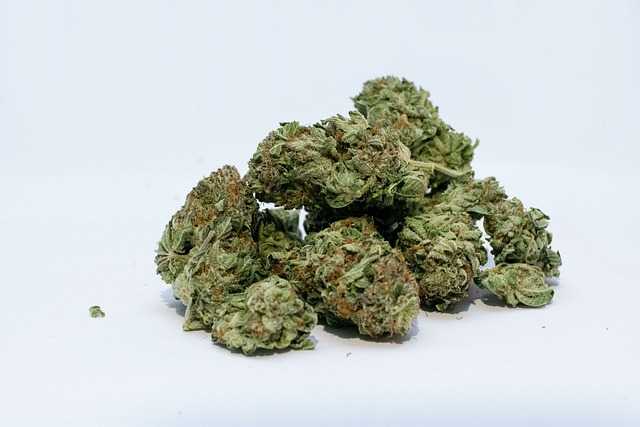This professional guide aims to provide solutions for common issues that arise during the flowering stage of cannabis cultivation. It combines scientific knowledge and practical experience to help growers identify and rectify common cannabis flowering issues, thus optimizing their yield and quality. With a focus on problem detection, understanding the causes, and implementing effective solutions, this guide is a valuable resource for both novice and experienced cannabis cultivators.
1. Recognizing Common Signs of Cannabis Flowering Problems: What to Look For?
During the flowering stage of cannabis plants, it is crucial to be vigilant and proactive in identifying any potential issues that may arise. By recognizing common signs of flowering problems, growers can take appropriate measures to address them promptly and ensure healthy plant development. One common sign to look for is the appearance of yellowing or browning leaves. This may indicate nutrient deficiencies or imbalances, such as nitrogen, phosphorus, or potassium deficiencies. Additionally, if the leaves start to curl or develop spots, it could be a sign of nutrient burn or a pest infestation.
Another important sign to watch out for is stunted growth or lack of bud development. If the plants are not producing buds as expected, it may be due to factors such as inadequate lighting, improper temperature, or insufficient nutrients. Additionally, if the buds appear small, airy, or loose, it could be a result of poor pollination or low-quality genetics.
Furthermore, the presence of mold or mildew on the buds or leaves is a clear indication of a problem. Mold can thrive in humid environments, especially if there is poor air circulation. It is essential to address this issue promptly to prevent further spread and potential damage to the entire crop.
Moreover, the appearance of pests such as aphids, spider mites, or whiteflies can significantly impact the flowering stage. These pests feed on the plant's sap, causing damage to the leaves and buds. It is crucial to identify and control these pests promptly to avoid severe infestations and potential crop loss.
Finally, pay attention to any abnormal odors emitted by the plants. A strong, unpleasant smell, especially when combined with other signs such as discolored leaves or wilting, may indicate the presence of root rot or other fungal diseases.
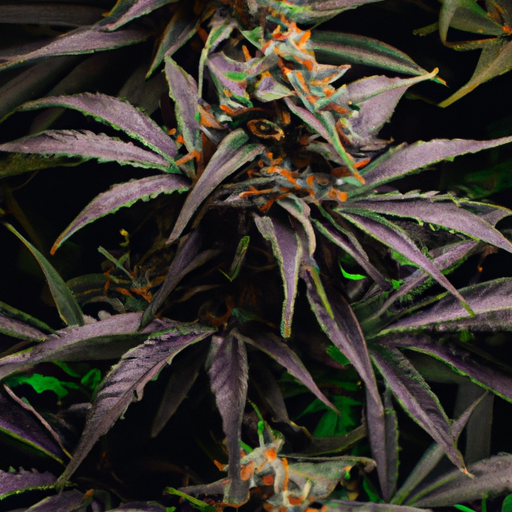
1. An image showing common signs of cannabis flowering problems, such as discolored, curling, or wilting leaves
2. 'An Ounce of Prevention is Worth a Pound of Cure': Preventing Flowering Issues
Preventing flowering issues in cannabis plants is always preferable to dealing with them once they have already occurred. By implementing proactive measures, growers can minimize the risk of encountering problems during the flowering stage and ensure a successful harvest.
One important aspect of prevention is maintaining a healthy growing environment. This includes providing the plants with optimal lighting, temperature, and humidity levels. Adequate lighting is crucial for photosynthesis and bud development, so investing in high-quality grow lights is essential. Additionally, maintaining a consistent temperature and humidity range within the recommended parameters for flowering cannabis plants can help prevent stress and the development of mold or mildew.
Another key preventive measure is ensuring proper nutrition for the plants. This involves providing them with a balanced nutrient solution throughout their life cycle, including the flowering stage. It is important to monitor nutrient levels and adjust accordingly to prevent deficiencies or excesses that can negatively impact bud development. Using organic fertilizers or supplements specifically formulated for cannabis can also help promote healthy growth and flowering.
Furthermore, implementing a pest management strategy is crucial in preventing pest infestations during the flowering stage. Regularly inspecting the plants for signs of pests, such as yellowing leaves or webbing, and using preventive measures like neem oil or beneficial insects can help keep pests at bay. Additionally, practicing good hygiene by cleaning grow tents, tools, and pots regularly can reduce the risk of introducing pests or diseases to the plants.
3. Nutrient Deficiency During Flowering Stage: How to Solve?
During the flowering stage of cannabis plants, nutrient deficiencies can occur, leading to stunted growth, yellowing leaves, and reduced bud development. It is crucial to identify these deficiencies early and take prompt action to rectify them. The most common nutrient deficiencies during the flowering stage include nitrogen, phosphorus, potassium, magnesium, and calcium.
To address a nitrogen deficiency, growers can apply a nitrogen-rich fertilizer or supplement to provide the plants with the necessary nutrient. It is essential to carefully follow the manufacturer's instructions to avoid over-fertilizing the plants, which can lead to nutrient burn.
Phosphorus deficiency can be remedied by using a phosphorus-rich fertilizer or bloom booster specifically designed for the flowering stage. These products provide an extra boost of phosphorus, which is crucial for flower formation and overall plant health.
Potassium deficiency can be resolved by using a potassium-rich fertilizer or supplement. Potassium is essential for the development of healthy flowers and plays a role in various plant functions, including nutrient uptake and water regulation.
Magnesium deficiency can be addressed by applying a magnesium supplement or using Epsom salt, which is rich in magnesium. This nutrient is vital for chlorophyll production and overall plant metabolism.
Calcium deficiency can be solved by adding a calcium-rich supplement or using a calcium-magnesium product. Calcium plays a crucial role in cell wall development and nutrient transport within the plant.
However, it is important to note that nutrient deficiencies can often be a result of imbalances in the pH levels of the soil or growing medium. Therefore, regularly testing and adjusting the pH levels can help prevent and resolve nutrient deficiencies during the flowering stage.
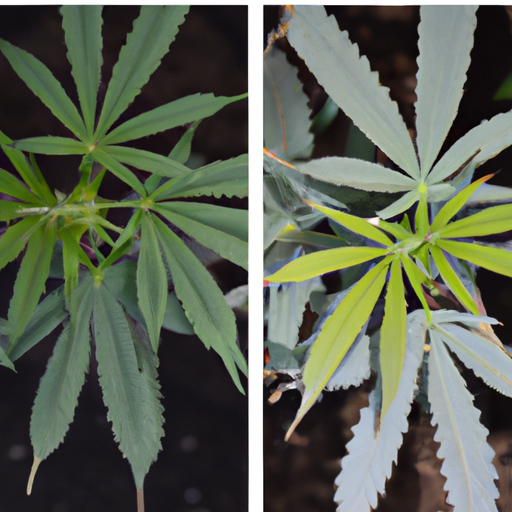
3. A photo showing a cannabis plant suffering from nutrient deficiency with a side-by-side comparison of a healthy plant
4. Overcoming Issues of Light and Heat Stress
Light and heat stress can have detrimental effects on cannabis plants during the flowering stage. Excessive heat and intense light can lead to reduced flower production, bleached or burnt leaves, and even plant death. To overcome these issues, growers can implement various strategies:
– Providing proper ventilation and airflow is essential to dissipate excess heat and maintain a suitable temperature range for cannabis plants. Using fans, exhaust systems, and air circulation techniques can help create a more favorable growing environment.
– Shading or filtering intense light can be done by using shade cloths, reflective materials, or adjusting the distance between the light source and plants. This helps to prevent light burn and ensures the plants receive the appropriate amount of light for healthy growth.
– Timely and careful placement of grow lights is crucial to prevent heat stress. LED lights, for example, produce less heat compared to traditional HID lights, reducing the risk of heat-related issues. Additionally, adjusting the intensity and duration of light exposure can help mitigate stress.
– Monitoring and maintaining optimal temperature and humidity levels in the grow space is vital. Temperatures around 75-85°F (24-29°C) during the day and slightly cooler at night, along with humidity levels between 40-50%, are generally recommended for the flowering stage.
5. Pest and Mold Issues: How to Identify and Counteract?
Pests and mold can pose significant threats to cannabis plants during the flowering stage, potentially compromising the quality and yield of the final product. It is crucial for growers to be able to identify and effectively counteract these issues.
One common pest that affects cannabis plants is spider mites. These tiny arachnids feed on the plant's sap, causing yellowing leaves, webbing, and stunted growth. To combat spider mites, growers can use organic insecticidal soaps, neem oil, or predatory mites that feed on spider mites. Regularly inspecting plants and maintaining a clean growing environment can also help prevent infestations.
Another common pest is the cannabis aphid. These small insects are usually green or black and suck the sap from the plant, leading to yellowing leaves and distorted growth. To control aphids, growers can use insecticidal soaps, neem oil, or introduce ladybugs, lacewings, or parasitic wasps, which are natural predators of aphids.
Mold is another issue that can arise during the flowering stage, especially in environments with high humidity or poor air circulation. Bud rot, caused by the fungus Botrytis cinerea, can quickly spread and destroy entire buds. To prevent mold, growers should maintain humidity levels between 40-50%, provide proper ventilation, and regularly inspect plants for signs of mold growth. If mold is detected, affected buds should be immediately removed and discarded to prevent further contamination.
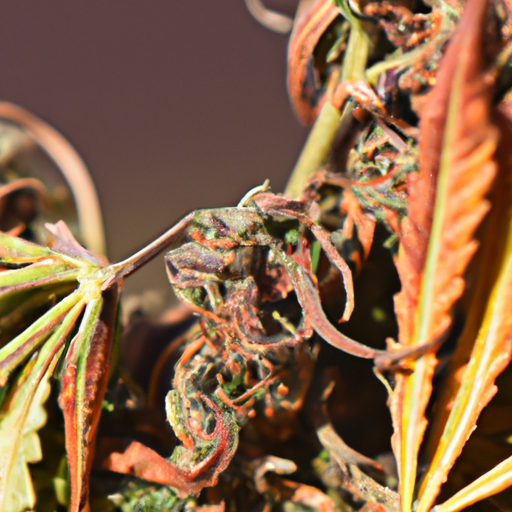
5. A close-up image of pest damage and mold infestation on cannabis flowers
6. Watering Woes: Are You Overwatering or Underwatering Your Cannabis?
Proper watering is crucial during the flowering stage of cannabis growth. Overwatering or underwatering can lead to various issues and negatively impact the health and development of the plants.
Overwatering can suffocate the roots and create an environment for root rot and fungal diseases to thrive. Signs of overwatering include yellowing leaves, wilting, and a damp soil surface. To address overwatering, growers should ensure that the soil has proper drainage and allow the top inch of soil to dry before watering again. Adjusting the watering frequency and volume can help prevent overwatering and promote healthy root development.
On the other hand, underwatering can lead to nutrient deficiencies, stunted growth, and wilting. Cannabis plants in the flowering stage require consistent moisture to support the development of dense and resinous buds. Signs of underwatering include drooping leaves, dry soil, and slow growth. To address underwatering, growers should water the plants thoroughly until excess water drains out from the bottom of the pots. It is important to maintain a consistent watering schedule and monitor the moisture levels of the soil to ensure the plants receive adequate hydration.
Finding the right balance of watering can be a challenge, but there are tools available to assist growers. Using a moisture meter or simply checking the weight of the pots can help determine when it's time to water. Additionally, adjusting the watering schedule based on the specific needs of each plant, such as size, pot size, and environmental conditions, can help prevent watering woes.
7. When Good Buds Go Bad: Bud Rot and How to Prevent It
Bud rot, also known as gray mold or botrytis, is a common issue that can devastate cannabis crops during the flowering stage. It is caused by a fungal infection that thrives in high humidity and damp conditions. Bud rot can quickly spread from one bud to another, leading to the loss of entire harvests if not properly addressed.
Early signs of bud rot include a fuzzy white or gray mold on the buds, a musty smell, and the presence of decaying plant matter. If left untreated, the affected buds will eventually turn brown or black and become soft and mushy. To prevent bud rot, it is crucial to create an environment that is unfavorable for fungal growth.
First and foremost, maintaining proper ventilation and airflow within the grow space is essential. Good air circulation helps prevent excess humidity and allows the buds to dry out between watering. Avoid overcrowding the plants and ensure there is enough space between them for air to circulate freely.
Controlling humidity levels is another crucial aspect of preventing bud rot. During the flowering stage, aim to keep the humidity levels between 40% and 50%. Using dehumidifiers or fans can help reduce humidity in the grow room. It is also advisable to remove any dead or decaying plant matter from the vicinity, as it can serve as a breeding ground for mold and fungi.
Regularly inspecting the plants for signs of bud rot is important. If you spot any affected buds, it is essential to remove them immediately to prevent the spread of the infection. Use sterilized scissors or pruning shears to carefully cut out the infected areas, making sure not to touch any healthy buds.
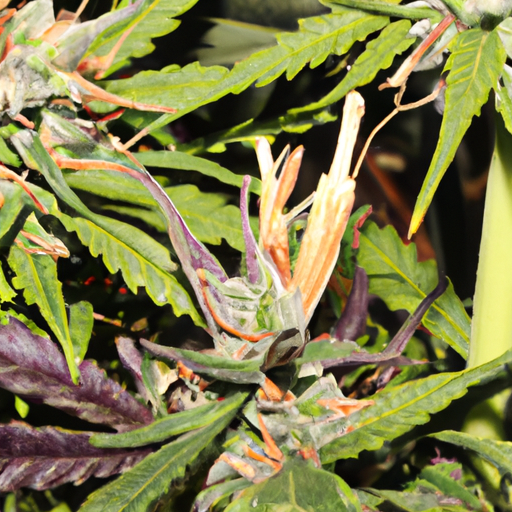
7. An image exhibiting bud rot in cannabis, with clear signs to look out for
Common Issues in Cannabis Flowering Stage:
| Issue | Cause | Detection | Solution |
|---|---|---|---|
| Lack of Nutrients | Improper fertilization or pH levels | Wilting or discoloration of leaves | Adjust nutrient levels and/or pH as needed |
| Insect or Disease Infestation | Increased humidity or inadequate pest control | Discoloration, spots, or holes in leaves | Reduce humidity and introduce pest control methods |
| Temperature Fluctuations | Unstable temperature or light cycles | Stunted growth or discoloration of leaves | Maintain consistent temperatures and lighting |
| Lack of Airflow | Inadequate ventilation | Fungus or mold growth on leaves | Increase airflow and introduce a fan |
Understanding and solving cannabis flowering problems can significantly impact the yield and quality of your crop. The flowering stage is critical, and any issues that arise during this period can adversely affect the final product. By identifying these problems early and implementing the provided solutions, you can ensure a healthy flowering stage for your cannabis plants. Remember, each plant is unique, and some may need more specific care than others. However, with patience, observation, and the right knowledge, you can overcome any obstacle that comes your way.




